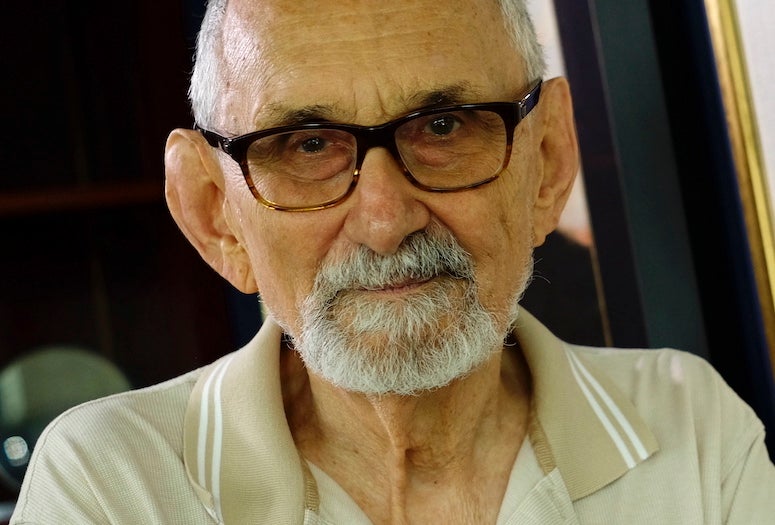Nobel Prize-winning chemist Robert Curl, an internationally acclaimed scientist and nanotechnology pioneer whose 64-year career at Rice University made him one of the institution’s most beloved and respected figures, died July 3 in Houston. He was 88.
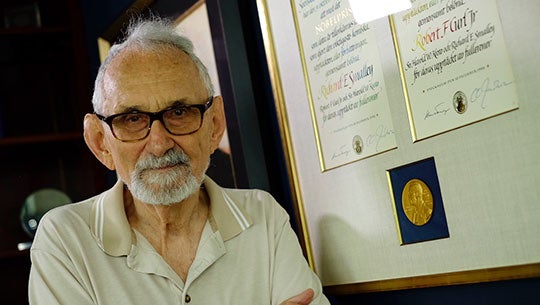
Curl, University Professor Emeritus and the Kenneth S. Pitzer-Schlumberger Professor Emeritus of Natural Sciences, spent most of his life at Rice. He earned a bachelor’s degree in chemistry from what was then the Rice Institute in 1954 and returned as an assistant professor in 1958 after Ph.D. studies at the University of California at Berkeley and a brief postdoctoral stint at Harvard University.
“Despite winning one of science’s top honors, Bob was a quiet hero who stayed true to his passions – scientific discovery, teaching and the spirit of collegiality,” said Rice President Reginald DesRoches. “During his 64 years as a faculty member at Rice, Bob mentored countless students and colleagues. His institutional presence on campus made a profound contribution to the university’s culture and character that will live on for years to come.”
Curl’s expertise was in physical chemistry and the use of lasers and microwave radiation to determine the structure of molecules and how they react. He, Rice’s Rick Smalley and Britain’s Harold Kroto shared the 1996 Nobel Prize for Chemistry for the discovery of carbon-60, or buckminsterfullerene, a closed, cage structure of 60 carbon atoms in the form of a soccer ball measuring about 1 billionth of a meter, or a nanometer, in diameter.
The buckyball discovery laid the foundation for Rice’s current leadership role in materials research,” said Tom Killian, dean of Rice’s Wiess School of Natural Sciences. “This fundamental research established a new field of organic chemistry, and it provided key inspiration for the ensuing rapid growth in the study of nanoparticles and nanomaterials and the emergence of nanotechnology.
Despite officially retiring in 2005, Curl continued to work. Rice chemist Bruce Weisman said Curl was a constant presence at seminars through the most recent semester.
“It’s really remarkable because these are not big events, with famous people speaking,” Weisman said. “These are part of our graduate program where students get to talk about their research, mostly to other students. Bob, despite having been retired for a long time and having no obligation at all to do this, would come just to satisfy his curiosity about what was going on, and also to help the students.
He was an extraordinary colleague, and despite his talent and his acclaim with the Nobel Prize, he was unfailingly modest and generous to other people with his time and attention,” Weisman said. “I think of him as the soul of our department. He made everybody around him better.
Born Aug. 23, 1933, in Alice, Texas, Curl was the son of an itinerant Methodist minister.
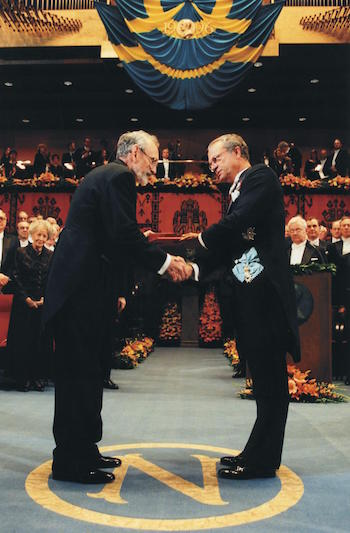
“In those days, Methodist ministers moved often, and as a child I lived in a succession of mostly small towns in south Texas: Alice, Brady, San Antonio, Kingsville, Del Rio, Brownsville, McAllen, Austin, then back to San Antonio,” Curl wrote in a short autobiography for the Nobel Foundation.
“I vividly remember my father telling me that one of my elementary school teachers had told him that I was not brilliant but I was a steady hard worker,” Curl wrote. “Somehow the further I progressed in school, the easier it became to do well.”
His interest in chemistry began when he received a chemistry set as a Christmas present at age 9.
“Within a week, I had decided to become a chemist and never wavered from that choice,” Curl wrote.
In an undergraduate chemistry course, Curl learned about Kenneth Pitzer's discovery of barriers to internal rotation about single bonds and decided to go to the University of California-Berkeley and work with Pitzer. Pitzer, who would become Rice’s third president in 1961, was Curl’s Ph.D. adviser and helped him get a postdoctoral position studying microwave spectroscopy with E. Bright Wilson at Harvard in 1957.
Curl continued those studies when he was recruited to Rice as an assistant professor the following year. He would go on to spend most of his career studying the spectra, structures and kinetics of free radicals and other substances via spectroscopy.
“He would never have called himself a nanotechnologist,” said James Heath ’88, president of the Institute of Systems Biology in Seattle and the principal graduate student involved with the buckyball discovery.
“You've got physical chemistry, where people work on various levels of quantitation,” Heath said. “And then you've got spectroscopy, which is the most quantitative aspect of physical chemistry. And that really is what Bob loved.
You could say he was an unwitting father of nanotechnology, or an unwilling one,” Heath said. “Because he did get that mantle, but it wasn't one that he sought, and it wasn't one that he tried to nurture. He never deviated from being a spectroscopist. That’s always that precision bit of physical chemistry that he loved.
Curl became a full professor in 1967 and earned a reputation as a good listener and a caring mentor to students. From 1968 to 1972, Curl and his wife, Jonel, served as magisters of Lovett College, one of Rice’s residential colleges for undergraduate students. Among the students Curl nurtured at Lovett was R. Stanley Williams ‘74, now a professor of electrical and computer engineering at Texas A&M University after a storied career at Hewlett Packard Labs.
“I had no idea what I was getting into,” Williams recalled. “College was just this thing I knew I wanted to do, but I had absolutely no expectations about what it would be like.”
Williams met Curl shortly after arriving on campus.
“I thought that I was interested in chemistry,” he said. “I didn't know anything about it, other than what I had taken in high school. So I asked Bob if I could visit his lab and if he had anything I could do.”
Williams expected to start with menial lab work, washing glassware. “Instead, he took me into his office and put a piece of chalk in my hands, stood me up at the blackboard and started teaching me quantum mechanics before I knew anything about calculus, or much science at all. He was wondering if he could teach quantum mechanics, essentially, from the Heisenberg approach. And I actually kind of got it.
I view Bob as the gentle intellectual giant,” Williams said. “He was so intelligent, but also very humble. I’ve now known a large number of Nobel Prize winners, people who are very high in scientific hierarchy, and most of them are fairly full of themselves and not necessarily the nicest people. Whereas Bob was absolutely the nicest person. When we chatted about science, his eyes would just literally light up and sparkle. I would come away from every discussion that I had with Bob energized.
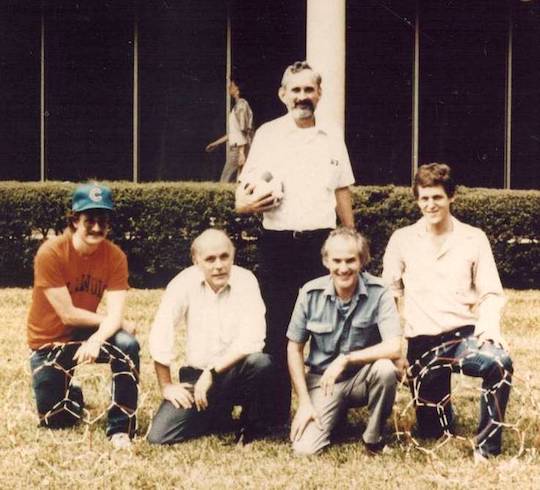
In the early 1980s, Curl and Smalley published several studies on semiconductors based on experiments with a laser beam apparatus in Smalley’s lab called AP2 that could vaporize nearly any known material into plasma. Kroto, a friend of Curl’s who was then a professor at the University of Sussex, called in 1985 and asked Curl to introduce him to Smalley so he could inquire about using the apparatus to simulate and study the formation of carbon chains in red giant stars.
“We got into the carbon business because of Harry’s interest in carbon chain molecules that he had identified in interstellar clouds by radio astronomy,” Curl recalled in a 2016 Rice News interview marking the 20th anniversary of the Nobel award for the research. “Harry proposed that unlike other interstellar molecules that are known to be produced by more complex chemistry, these chains were simply produced by carbon condensation.”
The experiments were carried out over 11 days in early September 1985 by then Rice graduate students Heath, Sean O’Brien and Yuan Liu. The spectrographic data included an odd peak at 60, meaning the apparatus had produced a great deal of carbon clusters containing exactly 60 atoms. Those turned out to be buckyballs, which Smalley dubbed buckminsterfullerene because they reminded him of architect Buckminster Fuller’s geodesic domes.
The idea that the molecule might be a hollow cage of carbon atoms was novel, but Heath said he, Smalley and Kroto were convinced it was the structure.
We were like, ‘Oh, this is right. Has to be right. It just explains everything.’ And Bob was like, ‘Nah. I'm not sure about that.’
Heath said Curl knew the cage-like molecule would be structurally unstable unless it contained the sort of conjugated bonds that would produce a “resonance stabilized” structure similar to the one found in benzene.
“Bob wanted to make sure it was resonance stabilized, meaning that you could draw conjugated double bonds around the whole structure,” Heath said, recalling that it took the better part of a day for Curl to make the necessary calculations to verify the stability of the structure.
“It turns out, there's something like 12,500 resonant structures, a lot of resonant structures, because they go up geometrically with the number of atoms,” Heath said. “But at the time we didn't know that, and that was the sort of thing that Bob had to be convinced of before he would sign his name on it. So we spent the entire day cutting out little double-bond things and sticking them on the soccer ball.”
At the time, carbon was known to take three well-known forms: amorphous (like soot or coal), graphite and diamond. The idea that there was another form was initially rejected by many chemists.
“The reviewers of our letter to Nature were dubious that it was correct, but they said, ‘Well, it’s interesting, be it on their head if it’s wrong. Publish it,’” Curl recalled in 2016.
Smalley and Kroto would later laud Curl’s attention to detail in checking and rechecking key portions of the paper prior to submission. Heath said Smalley told him he stayed at Rice because of Curl.
“They were very different people,” Heath said. “Rick was incredibly charismatic, incredibly hard-driving, and sometimes he would out-accelerate himself. You know, get over his skis a little bit. And Bob was basically the insurance policy. I think that's a reasonable way to put it.
Rick was always getting offers, and he told me he stayed because of Bob,” Heath said. “Because the collaboration between the two of them was so rich, and, you know, Bob kept him in line.
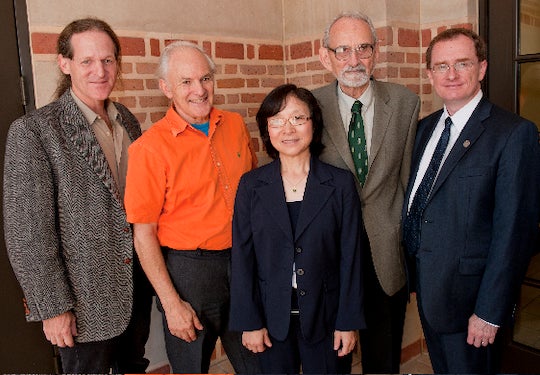
Rice chemist James Tour never worked directly on a project with Curl but recalled the attention Curl gave to a paper that Tour and colleagues submitted to the Proceedings of the National Academy of Sciences while Curl was managing editor.
“Unlike any other editor, he met with me and my colleagues on three or four occasions for two hours at a time to help us improve the manuscript,” Tour said. “He really had an eye for science, and he read and re-read the paper before he even sent it out for reviews. Bob was a real stickler for detail and accuracy.”
Curl said he lost interest in nanotechnology and carbon fullerenes, in part, because he did not “want to be in any field where it would be a full-time job keeping up with the literature,” and because he was more interested in mathematical challenges than those posed by synthetic chemistry.
He served as chair of the chemistry department from 1992 to 1996, and was promoted to the university’s highest rank, University Professor, in 2003.
Curl was preceded in death by Smalley in 2005 and Kroto in 2016. In 2015, Rice named the interdisciplinary Smalley-Curl Institute in Curl’s and Smalley’s honor. The institute traces its roots to Rice’s first interdisciplinary institute, which Curl, Smalley and others co-founded in 1979 to study quantum phenomena.
In recent years, Curl turned his attention to economics, working with Rice political economist Dagobert Brito, also a faculty scholar at Rice’s Baker Institute for Public Policy, to mathematically model such disparate subjects as coal versus gas for energy production and the effects of automation on the nation’s economy.
Curl’s numerous honors include the Clayton Prize from the Institute of Mechanical Engineers, the Alexander von Humboldt Senior US Scientist Award from the University of Bonn, Germany, the International Prize for New Materials from the American Physical Society, the Johannes Marcus Marci Award in Spectroscopy and the Centenary Medal from the Royal Society of Chemistry. He was a fellow of the National Academy of Sciences, the American Academy of Arts and Sciences and the Optical Society of America, an honorary fellow of the Royal Society of New Zealand, and a member of Phi Beta Kappa, Phi Lamba Upsilon and Sigma Xi.
Curl’s reputation for humility and service are illustrated by a story Tour recalled hearing from the late Malcolm Gillis, Rice’s sixth president, as well as by Curl’s own words to the Rice News in 2016.
Tour said, “When Bob and Smalley got the Nobel Prize, (Gillis) brought them to the office and said, ‘What can I do for you two guys? What do you want?’ And Bob’s big request was, ‘Could you put a bicycle rack over there by the Space Science building, where my office is?’”
In 2016, when Curl was asked if his status as a Nobel laureate came with an added responsibility to help other researchers, he said “It’s a responsibility that everybody has! If your colleague comes to you and wants to discuss something with you, it would be a crime to not discuss it.
As (people at Rice) probably will tell you, I love to ask questions. I’m not too keen about answering questions, but I love to ask questions. And I try to ask questions that make me think and maybe sometimes make them think.
Curl was preceded in death by his sister, Mary Kurio of Austin, Texas. Survivors include his wife of 66 years, Jonel Curl of Houston, two sons, Mike Curl of Houston and David Curl of Fort Worth, Texas, and three grandchildren.

